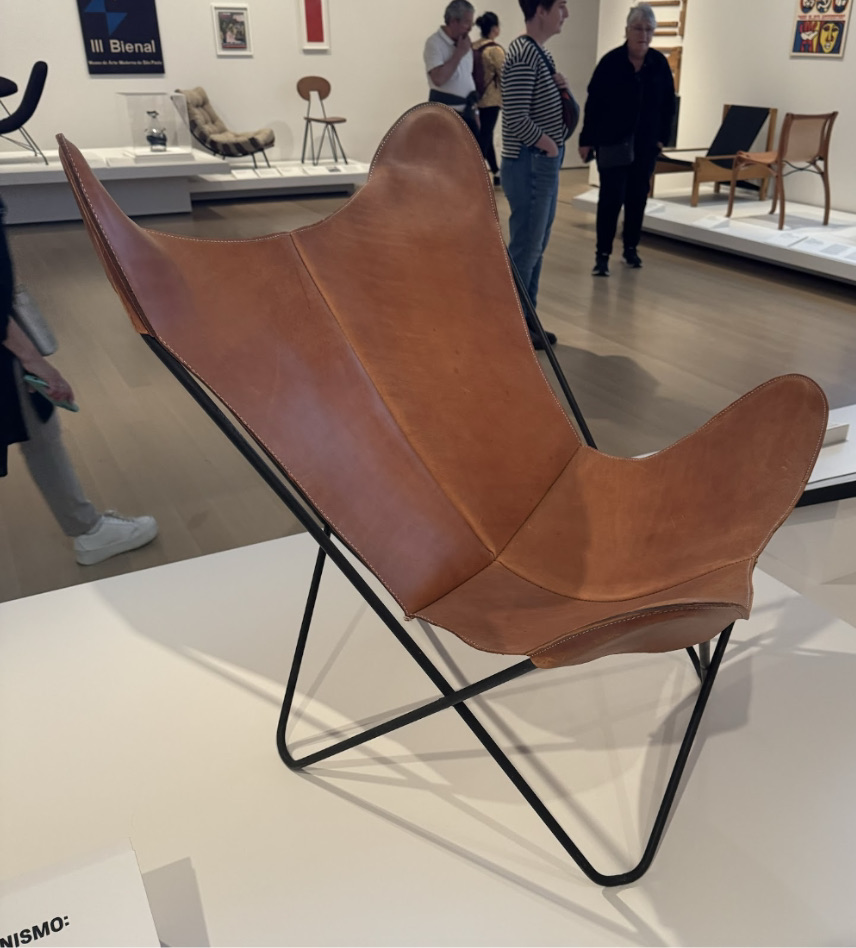Human nature is always changing. Our methods of being are never stagnant, exponentially evolving with each passing day. This movement is not new, though. Dating back to prehistoric periods, early humans were always moving, adapting and advancing as a result of it. I never thought, however, that creative concepts would be involved in this movement. I often assumed that artists and creative ideas only influenced the region in which they were created. The New York Museum of Modern Art’s newest exhibit “Crafting Modernity: Design in Latin America” has proven to me that this could not be further from the truth.
As soon as I emerged from the third-floor elevator in New York’s midtown art mecca, I was confronted with a detective board: various names and places connected by red and black lines surrounding a few larger names that seemed to be more significant. Having only lived in New York for just over a year and still being extremely unfamiliar with the city’s urban layout, I suspected that I had accidentally wandered into the investigative unit at NYPD headquarters. I stuck my hand backwards as the elevator door was closing, consciously planning my escape considering that I found myself somewhere highly confidential.
Then, I noticed the word “Colombia” just above the chart, and that the various names and places in front of me were actually the names of designers, companies and art schools that were all somehow linked to each other. My fear turned to curiosity, and I stepped forward and began to read about these seemingly infinite connections. What I discovered challenged my long-standing perceptions of what creativity could be. “Corbusier,” “Bardi,” “Grabe”: the names appearing before me weren’t Hispanic. But the more I continued reading, the more I began to realize what the reason behind this was. Many of Latin America’s most celebrated designers weren’t even Latin. Yes, there were (and still are) many brilliant modern minds that were nurtured in Latin America, but so many pieces that sparked Latin America’s modernist movement were developed by European creatives.
Entering through a stark white opening, the exhibit revealed itself to me, a vast array of interior design pieces ranging from furniture to metal bar carts. On my left, I noticed a wooden chair held steady by a black metal frame with a khaki (albeit faded) cushion that lounged at a 110-degree angle. This piece by Austrian-born designer Martin Eisler was developed in Brazil 20 years after his move to South America in the mid-1930s. The natural tones are a clear homage to the foliage that spans Brazil’s landscape, but the metal base can be attributed to the brutalist principles that swept through Germany and surrounding areas in the early 20th century. Continuing through the exhibit off-balance, I paid close attention to the materials and themes that persisted throughout the pieces. As I passed chairs of various forms, paintings and other works, I began to distinguish the influence of Western culture on Latin design. All of them were minimal in nature, with sleek, abstract details that allowed the object to push the boundaries of form. This does not mean, however, that the environment and culture did not influence the works in their own way. This became abundantly clear through the heavy use of leather, a byproduct of the cow farms that litter the Latin American countryside.
Going to any art museum, one will notice that the curator intentionally places important pieces directly across from the entrance of a room. It is a strategic move, an attempt to garner interest from the viewers and lure them into the space. The Metropolitan Museum of Art has done this famously with Leutze’s “Washington Crossing the Delaware,” which sits at the end of a long corridor where it can be seen from multiple rooms away. The same can be said of the “B.K.F. Chair” within “Crafting Modernity,” which sits in a similar way at the center of the exhibit. As I visited other pieces on the perimeter, I couldn’t help but keep a wandering eye in its direction. When I finally made my way over to the chair, I was exposed to the history and creative vision that put it in that position. The story is far from simple. Antonio Bonet, Juan Kurchan and Jorge Ferrari Hardoy met in the studio of groundbreaking architect Le Corbusier. From there, they moved to Buenos Aires and formed the design collective Grupo Austral, developing the B.K.F. chair (the name coming from a combination of their initials) as one of their signature pieces. Visually, it’s easy to understand the acclaim. A triangular steel frame holds up a firm piece of brown leather, which rests in a hammock-like position. Almost immediately after admiring this piece, a sharp 90-degree turn led me down a hallway and away from the exhibit. It was clear to me that the curator recognized that the B.K.F. Chair was unique, and a fitting note to end a spectacular experience.
“Crafting Modernity” is a spectacle, and it maintains the ideas that defined Latin American design throughout the majority of the 20th century. It is not about mixing tradition with form, but instead about creating tradition by breaking boundaries. So, if you walk into this exhibit with stereotypical expectations of what color and creation in Latin America “should” be, expect to leave disappointed in your findings. Instead, enter with an open mind and heart, and surrender yourself to the idea of the unexpected.







































































































































































































